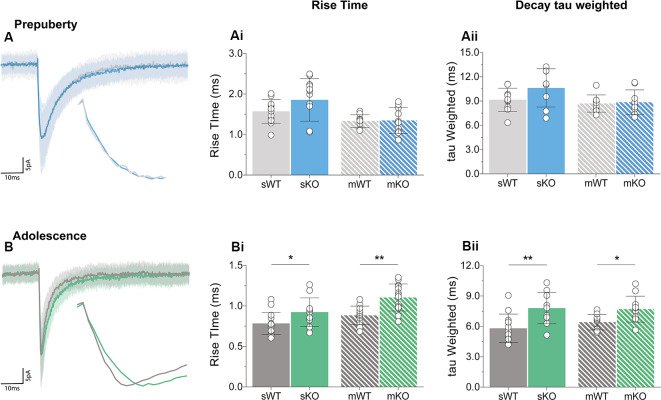Figure 3.
Receptor activation and decay times significantly prolonged in adolescent mPFC. Averages of 50–100 example IPSCs (Average: solid lines, SD: shaded area) during pre-puberty (A) and adolescence (B). During pre-puberty both synaptic rise times [Ai, sIPSC (WT(n = 12) = 1.57 ± 0.29 ms, KO(n = 12) = 1.86 ± 0.53 ms, p = 0.12), mIPSC p = 0.89] and weighted tau of decays [Aii, sIPSC (WT(n = 10) = 9.15 ± 1.43 ms, KO(n = 8) = 10.63 ± 2.37 ms, p = 0.12), mIPSC p = 0.80] were similar for the two genotypes in spontaneous and miniature IPSC recordings. (B) Receptor activation times were significantly prolonged during adolescence in both conditions [Bi, sIPSC (WT(n = 14) = 0.78 ± 0.14 ms, KO(n = 11) = 0.92 ± 0.18 ms, p = 0.04), mIPSC (WT(n = 13) = 0.88 ± 0.11 ms, KO(n = 14) = 1.10 ± 0.17 ms, p < 0.01)]. Additionally, adolescent weighted tau of decay was also prolonged [Bii, sIPSC (WT(n = 13) = 5.81 ± 1.41 ms, KO(n = 10) = 7.81 ± 1.56 ms, p < 0.01), mIPSC (WT(n = 10) = 6.41 ± 0.76 ms, KO(n = 11) = 7.70 ± 1.28 ms, p = 0.01)], independently of tetrodotoxin application (Supplementary Table S1). Genotypic differences were assessed with the Student’s t-test. For all panels asterisks denote statistical significances of **p < 0.01, *p < 0.05. Error bars represent SD.

